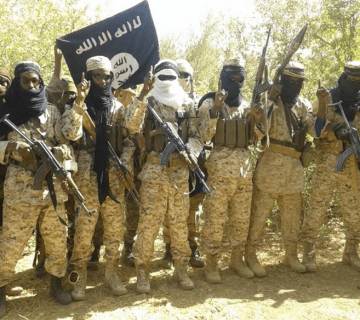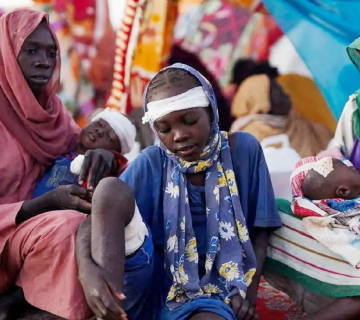Kenya’s interest in its blue economy, which has the potential to improve the country’s economic outlook, has increased significantly in recent times. However, the management of this economy could either lead to prosperity or threaten the stability and peace of Kenya and the region. Kenya’s prospects are promising, but she has to resolve outstanding disputes, build its naval capacity, and find partners to help in the exploration of its off-shore resources.
Last year, Kenya hosted a high-level conference, Sustainable Blue Economy Conference. This global conference explored ways to utilize the Indian Ocean better (for marine transport, tourism, and off-shore energy resources) to improve livelihoods. Maritime transport is a key driver of Kenya’s development. The major wet port is Mombasa, but there are other smaller ports along the Kenyan shoreline including Mtwapa, Kiunga, Lamu, Funzi, Vanga, Shimoni, and Malindi. The Mombasa port is also one of the busiest ports in Africa and has the capacity to handle all sorts of vessels and cargo not only for Kenya, but also landlocked countries within the region such as Uganda, Rwanda, Ethiopia, Burundi, and South Sudan. Trade within the region has been influenced by harmonization of various policies such as the free trade regime in the East African Community (EAC) that has led to minimization of tariff and non-tariff trade barriers.
The maritime transport sector supports other sectors of Kenya’s economy such as natural resource exploration. The country’s on-shore oil resources in Lokichar, Turkana County, for example, are estimated to amount to about 560 million barrels. Tullow Oil, a multinational oil and gas exploration company, has been contracted to extract this oil. This oil will bring some blue economy benefits such as employment, and revenue from customs duty if it is shipped to international markets. In August 2019, President Uhuru Kenyatta flagged off the first 200,000 barrels of that oil (from Turkana) to Malaysia worth KES 1.3 billion at the port of Mombasa. This export marked Kenya’s entry into the list of oil-exporting countries in the world. According to the Kenya Ports Authority (KPA), who manages Kenya’s wet ports, the Mombasa port serves more than 30 shipping lines connecting to over 80 seaports worldwide. In the financial report for the year ended June 2017, KPA earned at the port KES 41,572.5 million. The figures are likely to increase if Kenya ventures more into off-shore exploration. This depends on the resolution of the ongoing dispute between Kenya and Somalia over a vast area of oil and gas deposits.
Another aspect of the blue economy that Kenya has been exploring is tourism. In general, tourism is also one of the country’s top foreign exchange earners. According to the Kenya Tourism Board’s Performance Report of 2018, more than two million foreigners visited the country in 2018. 73.9 per cent were tourists and most of them visited the coastal areas.
Drivers for tourism growth in 2018 were mainly political stability and improved the security situation, especially in the coastal regions where piracy and abduction of tourists by al Shabab peaked in 2011. Kenya launched Operation Linda Nchi with the main goal of decimating al Shabab attacks in the country following numerous attacks and threats by the al Qaida-linked terror group. In this Operation, Kenya Defence Forces (KDF) led an incursion into southern Somalia. Later on, in 2012, they were integrated into regional peacekeeping force, African Union Mission in Somalia (AMISOM) after the United Nations Security Council passed Resolution 2036 to reinforce security in the terror-prone country.
Legal Issues
Relations between Somali and Kenya became frosty when Somalia filed a case at the International Court of Justice (ICJ) against Kenya on August 28, 2014, over a disputed area in the Indian Ocean that both states claim. Kenya’s argument is that the line runs parallel to the line of latitude eastwards, taking the straight-line principle while Somalia’s claim is that the line should run southeast, taking an equidistant principle. The United Nations Convention on the Law of the Sea (UNCLOS) has categorized marine areas into five main zones: internal waters, territorial waters, contiguous zone, exclusive economic zone (EEZ), and high seas.
The internal waters comprise of ports, rivers among others. Coastal states have jurisdiction over their territorial waters and can pass an unlimited number of domestic laws to govern this area. These states also have the right to territorial sea encompassing up to 12 nautical miles (nm) from the baseline, and to occupation and enforce laws on maritime areas up to 24 nm from the baseline. The EEZ lies between the territorial sea and the high seas extending up to 200 nm of the territorial sea. This is the region where states maintain economic sovereignty in exploring natural resources and to conserve the maritime ecosystem. The high seas, which is located beyond 200 nm of the EEZ is generally a no man’s area. It is one of the four major global commons articulated in international law, and is governed by the principle of equal rights of all.
The area at the center of the Kenya-Somalia maritime boundary dispute is approximately 100,000 square kilometers and extends beyond the EEZ into the continental shelf beyond 200 nm. The area is also purported to have a total capacity of 100 billion barrels of oil deposits making this maritime dispute both territorial and functional. The oral hearings of this case which were to take place on September 9-13, 2019 have been postponed to November 4, 2019.
Paradigm Shift
Kenya’s increasing interest in exploring its ocean resources is dependent on the ICJ ruling. If Kenya wins, she will continue to develop its blue economy. The Court could also leave the matter to the disputing states to resolve, including issues like piracy and illegal migration that threaten the maritime economy of the two states. Kenya fears that an unfavorable ruling will lead to the loss of about 26 per cent of its EEZ. Off-shore exploration may also be limited by lack of direct access to the high seas. In such circumstances, there is a need for Kenya to claim and protect its territorial integrity. These events have called for an end to ‘sea blindness’ of both states (traditionally, states focused more on land than the sea as a major factor of production).
What Next for Kenya?
According to Article 299 (2) of UNCLOS, Somalia and Kenya can still withdraw the case from the ICJ and come up with another mechanism in settling the matter out of court. Kenya should have strategic negotiations with Somalia over the disputed area. It could be too late for them to engage in negotiations but an out of court settlement of the matter would be best for both states endorsing a non-zero sum situation. An example is the maritime dispute between China and Philippines where ICJ ruled against the former, but both parties opted for dialogue.
Unfortunately, for the case of Africa, regional mechanisms for solving maritime conflicts are relatively weak. They lack skilled and experienced personnel who are well versed in maritime issues, as well as financial capabilities in addressing maritime problems within the continent. This usually pushes African states to seek assistance at the international level from bodies such as the ICJ. This means that Kenya’s new legal team should present facts on its case convincingly before the Court. As a last resort, Kenya could effectively occupy the territory to secure its blue economy.
Asia M. Yusuf, Communications and Research Department, the HORN Institute.
Photo: A section of Kenya’s coastal line (Photo Credit: Africa Odessy)



